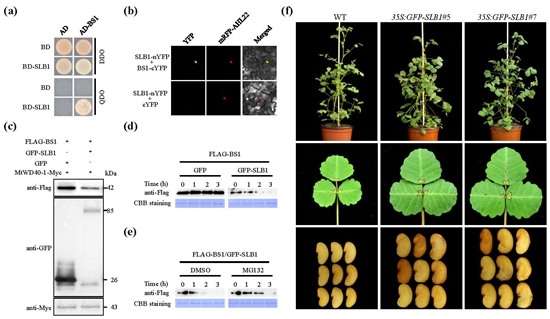SMALL LEAF AND BUSHY1 Controls Organ Size and Lateral Branching by Modulating the Stability of BIG SEED1 in Medicago Truncatula
Organ size is a major agronomic trait that determines grain yield and biomass production in crops. However, the molecular mechanisms controlling organ size, especially in legumes, are poorly understood. Using forward genetic approaches in a Tnt1 insertion mutant population of the model legume Medicago truncatula , we identified SMALL LEAF AND BUSHY1 ( SLB1 ), which is required for the control of organ size and lateral branching. Loss of function of SLB1 led to reduced leaf and flower size but increased lateral branch formation in M. truncatula . SLB1 encodes an F-box protein, an ortholog of Arabidopsis thaliana STERILE APETALA (SAP), that forms part of an SKP1/Cullin/F-box E3 ubiquitin ligase complex. Biochemical and genetic analyses revealed that SLB1 controls M. truncatula organ growth and lateral branching by modulating the stability of BIG SEED1 (BS1). Moreover, the overexpression of SLB1 increased seed and leaf size in both M. truncatula and soybean ( Glycine max ), indicating functional conservation. Our findings reveal a novel mechanism by which SLB1 targets BS1 for degradation to regulate M. truncatula organ size and shoot branching, providing a new genetic tool for increasing seed yield and biomass production in crop and forage legumes.

By Lin Hao (linhao@caas.cn)
-
 Apr 18, 2024Opening Ceremony of the Training Workshop on Wheat Head Scab Resistance Breeding and Pest Control in Africa Held in CAAS
Apr 18, 2024Opening Ceremony of the Training Workshop on Wheat Head Scab Resistance Breeding and Pest Control in Africa Held in CAAS -
 Apr 03, 2024IPPCAAS Co-organized the Training Workshop on Management and Application of Biopesticides in Nepal
Apr 03, 2024IPPCAAS Co-organized the Training Workshop on Management and Application of Biopesticides in Nepal -
 Mar 28, 2024Delegation from the School of Agriculture and Food Science of University College Dublin, Ireland Visit to IAS, CAAS
Mar 28, 2024Delegation from the School of Agriculture and Food Science of University College Dublin, Ireland Visit to IAS, CAAS -
 Mar 25, 2024Director of World Food Prize Foundation visited GSCAAS
Mar 25, 2024Director of World Food Prize Foundation visited GSCAAS -
 Mar 20, 2024Institute of Crop Sciences (ICS) and Syngenta Group Global Seeds Advance Collaborative Research in the Seed Industry
Mar 20, 2024Institute of Crop Sciences (ICS) and Syngenta Group Global Seeds Advance Collaborative Research in the Seed Industry
